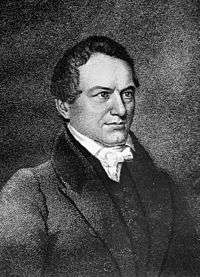Robert Y. Hayne
| Robert Young Hayne | |
|---|---|
 | |
| 32nd Intendant of Charleston, South Carolina | |
|
In office September 5, 1836 – September 4, 1837 | |
| Preceded by | Edward W. North |
| Succeeded by |
Henry Laurens Pinckney as Mayor |
| 54th Governor of South Carolina | |
|
In office December 10, 1832 – December 9, 1834 | |
| Lieutenant | Charles Cotesworth Pinckney |
| Preceded by | James Hamilton, Jr. |
| Succeeded by | George McDuffie |
| United States Senator from South Carolina | |
|
In office March 4, 1823 – December 13, 1832 | |
| Preceded by | William Smith |
| Succeeded by | John C. Calhoun |
| Chairman of the Senate Committee on Naval Affairs | |
|
In office 1825–1832 | |
| Preceded by | James Lloyd |
| Succeeded by | George M. Dallas |
| 5th Attorney General of South Carolina | |
|
In office December 18, 1818 – December 7, 1822 | |
| Governor |
John Geddes Thomas Bennett, Jr. |
| Preceded by | John Smythe Richardson Sr. |
| Succeeded by | James L. Petigru |
| 16th Speaker of the South Carolina House of Representatives | |
|
In office November 23, 1818 – December 18, 1818 | |
| Governor |
Andrew Pickens John Geddes |
| Preceded by | Thomas Bennett, Jr. |
| Succeeded by | Patrick Noble |
| Member of the South Carolina House of Representatives from St. Philip's and St. Michael's Parish | |
|
In office November 28, 1814 – December 18, 1818 | |
| Personal details | |
| Born |
November 10, 1791 St. Pauls Parish, South Carolina |
| Died |
September 24, 1839 (aged 47) Asheville, North Carolina |
| Political party | Democratic |
| Spouse(s) |
Frances Henrietta Pinckney Rebecca Mott Alston |
| Profession | Attorney, Soldier |
| Signature |
|
| Military service | |
| Allegiance | United States of America |
| Service/branch |
United States Army South Carolina militia |
| Rank |
Captain Quartermaster General |
| Unit | 3rd South Carolina Regiment |
| Battles/wars | War of 1812 |
Robert Young Hayne (November 10, 1791 – September 24, 1839) was an American political leader who served in the United States Senate from 1823 to 1832, was Governor of South Carolina 1832–1834, and as Mayor of Charleston 1836–1837. He was notable as a proponent of the states' rights doctrine, in collaboration with John C. Calhoun and James Hamilton, Jr.
Early life and career
Robert Y. Hayne was born into a planter family in St. Paul Parish, Colleton District, South Carolina. He received a private education and studied law in the office of Langdon Cheves in Charleston. He was admitted to the bar in 1812, and practiced in Charleston.
During the War of 1812 against Great Britain, he was a Captain in the Third South Carolina Regiment, and he later served as the Quartermaster General of the state militia.
A Democrat, he was a member of the South Carolina House of Representatives from 1814 to 1818, serving as Speaker of the House in 1818. Hayne was Attorney General of South Carolina from 1818 to 1822.
In 1822 Hayne was elected by the legislature to the United States Senate. He was reelected in 1828 and served from March 4, 1823, to December 13, 1832. From 1825 to 1832 he was Chairman of the Senate Committee on Naval Affairs.
In 1832, under James Hamilton, Jr. as governor, Hayne served as Chairman of South Carolina's nullification convention. This advocated Hamilton's and Hayne's view that states could "nullify" federal laws with which they did not agree. Eighty percent of its 162 delegates voted to nullify federal tariffs of 1828 and 1832, and for the Ordinance of Nullification. A temporary compromise was reached between the federal government and South Carolina in 1833.
Hayne resigned from the Senate to accept election by the legislature as Governor of South Carolina in 1832, serving one term into 1834.
From 1836 to 1837 he served as Mayor of Charleston.
Political views
Hayne was considered an ardent free-trader and an uncompromising advocate of states' rights. He consistently upheld the doctrine that slavery was a domestic institution and should be dealt with only by the individual states. He opposed the federal government's plan to send delegates to the Panama Congress, which was organized by Simón Bolívar to develop a united North and South American policy towards Spain, including the end of slavery in Spain's former colonies. (After achieving independence, Mexico ended slavery in 1836.) Objecting to any federal effort to curtail slavery, Hayne said, "The moment the federal government shall make the unhallowed attempt to interfere with the domestic concerns of the states; those states will consider themselves driven from the Union." His remarks are considered an early description of the idea of Secession, which culminated with the American Civil War.
He opposed the protectionist federal tariff bills of 1824, 1828, and 1832. In 1828, in response to the changing economic landscape in Massachusetts (there was a shift from farming towards mass production in factories), Daniel Webster backed a high-tariff bill to enhance the profitability of manufacturing interests in his home state. This angered Southern leaders who would have to pay higher prices for manufactured goods, and brought Webster into dispute with Hayne.
Their disagreement over the powers of the federal government later evolved into a series of back-and-forth Senate speeches that became known as the Webster-Hayne debate. The debate arose over the "Foot resolution," introduced on December 29, 1829[1] by Senator Samuel A. Foot of Connecticut. Foot's proposal called for a federal government study into restricting the sale of public lands to those lands already surveyed and available for sale, which would prevent states from conducting further land sales. Whether the federal government had the authority to take this action called into question the relationship between the powers of the federal government and the governments of the individual states.
Hayne contended that the United States Constitution was only a compact between the national government and the states, and that any state could nullify any federal law which it considered to be in contradiction.
Webster argued for the supremacy of the federal government and the Constitution, and against nullification and secession. He concluded his Second Reply to Hayne with the memorable phrase, "Liberty and union, now and forever, one and inseparable."
Later career
Hayne was president of the Louisville, Cincinnati and Charleston Railroad from 1836 until his death.
Family
Hayne's first wife was Frances Henrietta Pinckney (1790-1818). After her death, in 1820 he married Rebecca Brewton Alston. Her father, William Alston, gave her a lot on lower King Street where Hayne built a house (today's 4 Ladson Street); it was held by the family until 1863.[2]
Death
Robert Young Hayne died at Asheville, North Carolina on September 24, 1839. He was buried at St. Michael’s Churchyard in Charleston.
Hayne's nephew, Paul Hamilton Hayne, was a poet. In 1878 he published a biography of Hayne.
References
- ↑ New International Encyclopedia
- ↑ "Robert Young Hayne." http://www.HalseyMap.com/Flash/mayors-detail.asp?polID=28
Further reading
- Hayne, Paul H. Lives of Robert Y. Hayne and Hugh Swinton Legaré (Charleston, 1878)
- Jervey, Theodore D. Robert V. Hayne and his Times (New York, 1909).
- McDuffie, Eulogy upon the Life and Character of the Late Robert Y. Hayne (Charleston, 1840)
- Sheidley, Harlow W. "The Webster-Hayne Debate: Recasting New England's Sectionalism," New England Quarterly, 1994 67(1): 5-29. ISSN 0028-4866 Fulltext in Jstor
- Swift, Lindsay. (editor) The Great Debate Between Robert Y. Hayne, of South Carolina, and Daniel Webster, of Massachusetts (Boston, 1898), in the "Riverside Literature Series"
 This article incorporates text from a publication now in the public domain: Chisholm, Hugh, ed. (1911). "Hayne, Robert Y.". Encyclopædia Britannica (11th ed.). Cambridge University Press.
This article incorporates text from a publication now in the public domain: Chisholm, Hugh, ed. (1911). "Hayne, Robert Y.". Encyclopædia Britannica (11th ed.). Cambridge University Press.
External links
| Wikisource has the text of The New Student's Reference Work article about Robert Y. Hayne. |
- United States Congress. "Robert Y. Hayne (id: H000398)". Biographical Directory of the United States Congress.
| United States Senate | ||
|---|---|---|
| Preceded by William Smith |
U.S. Senator (Class 2) from South Carolina 1823–1832 Served alongside: John Gaillard, William Harper, William Smith, Stephen Decatur Miller |
Succeeded by John C. Calhoun |
| Political offices | ||
| Preceded by James Hamilton, Jr. |
Governor of South Carolina 1832–1834 |
Succeeded by George McDuffie |

